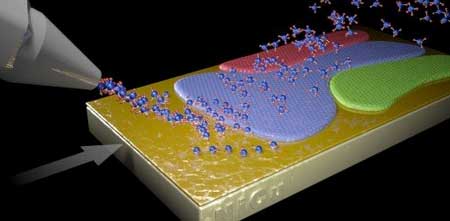| Posted: Sep 12, 2018 | |
Scaling up single-crystal graphene to over a foot long(Nanowerk News) Although thin layers of graphene and other two-dimensional materials can be made on the small scale required for research, to be useful these materials must be manufactured on a much larger scale. Researchers produced large, single-crystal-like graphene films more than a foot long using a new method they developed (Nature Materials, "Evolutionary selection growth of two-dimensional materials on polycrystalline substrates"). |
|
| This method, which produces a single layer of graphene, relies on harnessing a “survival of the fittest” competition among graphene crystals. | |
 |
|
| A spray jet directs chemical vapor deposition of a foot-long single layer of graphene on a moving surface (gold). The fastest growing graphene (blue) overwhelms graphene lattices of other orientations (red and green) and gets “evolutionarily selected” into a single crystal, even on a surface made from different (blue, green, and red) crystals. (Image: Andy Sproles, Oak Ridge National Laboratory) | |
| The novel technique may open new doors for growing high-quality sheets of materials. The materials are needed for long-awaited applications. Graphene has unprecedented strength and high charge carrier mobility. It is promising for improving sensors, fuel cells, solar cells, and electronics. | |
| A research team used chemical vapor deposition—with a twist—to localize control of the synthesis process and allow evolutionary, or self-selecting, growth under optimal conditions to produce a large, single-crystal-like sheet of graphene. The researchers sprayed a gaseous mixture of hydrocarbon precursor molecules onto a metallic, polycrystalline foil. | |
| They carefully controlled the local deposition of the hydrocarbon molecules, bringing them directly to the edge of the emerging graphene film. As the substrate moved underneath, the carbon atoms continuously assembled as a single crystal of graphene up to a foot in length. | |
| In this controlled environment, the fastest growing orientation of graphene crystals overwhelms the others and gets evolutionarily selected into a single crystal, even on a polycrystalline substrate, without having to match the substrate’s orientation. This method allows production of single-crystal graphene on virtually any flat surface. | |
| To characterize the quality of their single-crystal graphene, the researchers used a suite of techniques available at the Center for Nanophase Materials Sciences. Moreover, they developed a theory-based model to explain which crystal orientations are fittest for survival. | |
| Commercial application of graphene using the team’s survival-of-the fittest, single-crystal growth method remains to be seen, but the researchers believe their method could also be applied to other promising two-dimensional materials, such as boron nitride and molybdenum disulfide. |
| Source: Department of Energy, Office of Science | |
|
Subscribe to a free copy of one of our daily Nanowerk Newsletter Email Digests with a compilation of all of the day's news. |
